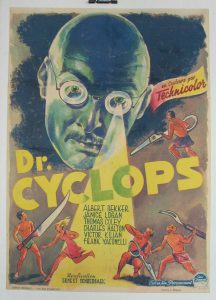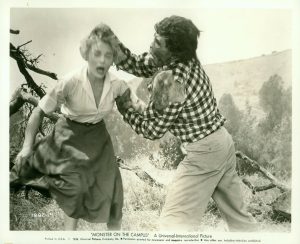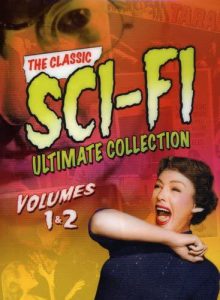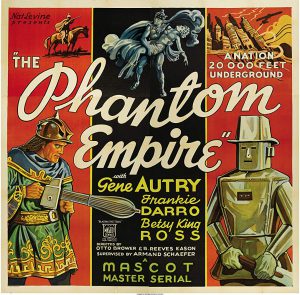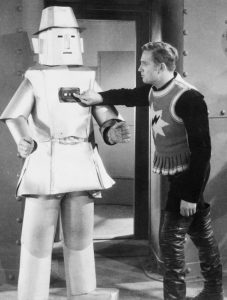This movie is one of the strongest memories I have from watching Not Quite Classic Theatre, that late night TV show of my youth. As I mentioned previously, the show aired on Saturday nights and would present old black and white monster movies from the 1940s and ’50s. When I first started watching, there would always be three of them. The first would start at 10:00 PM, the next around midnight, and the last one at about 2:00 AM. My attention would shift over the course of the night. The first movie would suck me in and keep me glued to my seat. Sometimes during the second movie, I would stand up and pace around the room – still paying attention to the story, but also thinking about how I might write my own version of the story. I would watch some scenes closely, while others would play in the background as I developed my own ideas. By the time the third movie came on, I was often immersed in my own creation and would sit making notes on a pad of paper while the movie carried on quietly in the corner.
I can’t say I have very clear memories of those third movies, but I would occasionally look at the TV and think “This looks pretty good. Next time I’ll have to pay attention to it.” Sadly, there was no next time for most of those films, and now I can’t even remember what most of them were. Actually, even the ones I paid close attention to are mostly lost in time now. I know I saw a whole slew of giant bug movies, but exactly which ones I’m not sure. In some cases, I know I’ve seen a certain movie, but I just can’t be sure that it was Not Quite Classic Theatre where I saw it.
The Monolith Monsters (1957), on the other hand, I know I saw on Not Quite Classic Theatre. The images of the giant monoliths growing taller, and then toppling over to smash into a million pieces, have stuck in my mind for decades. I’m not sure why, exactly. Maybe because those strange rocks from outer space were different from every other monster and giant bug I had seen before (or since). They were threatening the world by merely existing, not by any kind of design or intention – and they looked really cool and convincing. My understanding is that the effects were achieved with miniatures, and they still look good today.
I also know that The Monolith Monsters was not the first feature of the night. It was either the second or the third. The fact that it has remained in my consciousness all of these years leads me to suspect that it was the second feature. I would have still been paying enough attention to it, to able to appreciate it. On the other hand, maybe those monoliths were so unique and eye-catching, that they jumped off the screen at me even during the third and final feature of the night.
Watching The Monolith Monsters again for the first time since Not Quite Classic Theatre went off the air and became an obscure reference that no one but me seems to understand, I was struck by how little of the story I seemed to remember. Basically, it was all new to me except for the monoliths themselves, growing tall and toppling over; smashing into little pieces and multiplying. I did not recognize any of the characters, or the scenes that moved the plot forward. In my memory, the movie focussed solely on the monoliths, with only the occasional interruption by screaming humans in peril. In reality, the scenes of the monoliths were interspersed occasionally throughout the human drama that is front and centre of this sci-fi spectacle. And as an adult aficionado of B-moves, I say bravo!
As cool as the scenes of the monoliths are (and they are very cool), the movie would become tedious pretty fast if that’s all that was going on. The human drama is what makes it all work. And for the record, there is a horrifying side-effect caused by the monoliths – which I had no memory of – which causes much of the human drama and suspense.
The movie was directed by John Sherwood, who was a prolific assistant director. He only directed three feature films during his career, including The Creature Walks Among Us (1956). The Monolith Monsters was his last film as a director. He might have made more, but he died only two years later at the age of 57.
Grant Williams stars in The Monolith Monsters as Dave Miller, the head of the local geology department. He most famously played the title role in The Incredible Shrinking Man (1957). Oddly enough, he died at age 53. It might be tempting to think that this movie was cursed, but co-star Lola Albright, who plays a schoolteacher and Dave’s love interest, lived to the ripe old age of 92. She is perhaps most remembered as a cast member of the Peter Gunn TV series (1958–1961). But she appeared on many shows, including two of my childhood favourites, The Incredible Hulk (1977–1982) and Quincy M.E. (1976–1983)
The Monolith Monsters (1957) is a very special kind of #NotQuiteClassicCinema to me. It has all of the elements that I enjoy, but it was also part of the original Not Quite Classic Theatre lineup that inspired me to recreate the experience for myself all these years later (and brand it #NotQuiteClassicCinema). The nostalgia levels are off the charts with this one. And yet it has the perfect mix of stuff I’ve never forgotten, and stuff that seems completely new to me. A pure pleasure through and through. And althought I may be a little biased, I would recommend The Monolith Monsters for any movie marathon, or #FridayNightAtTheHomeDriveIn.
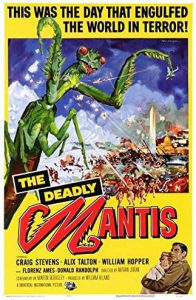 The Deadly Mantis (1957) by #NathanJuran
The Deadly Mantis (1957) by #NathanJuran
